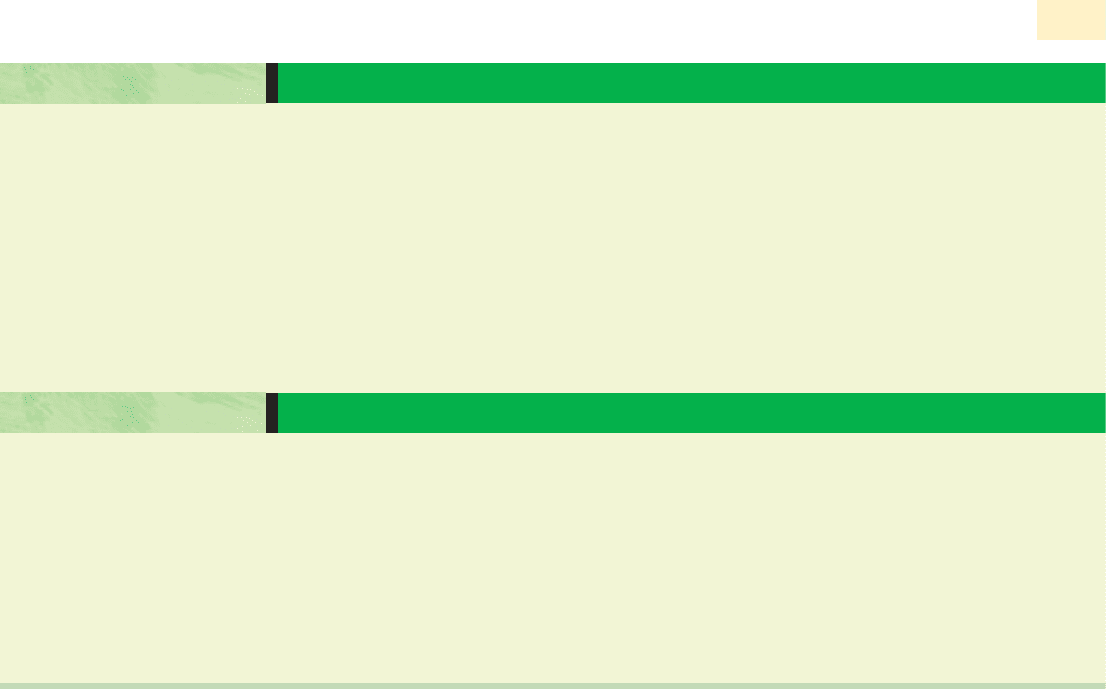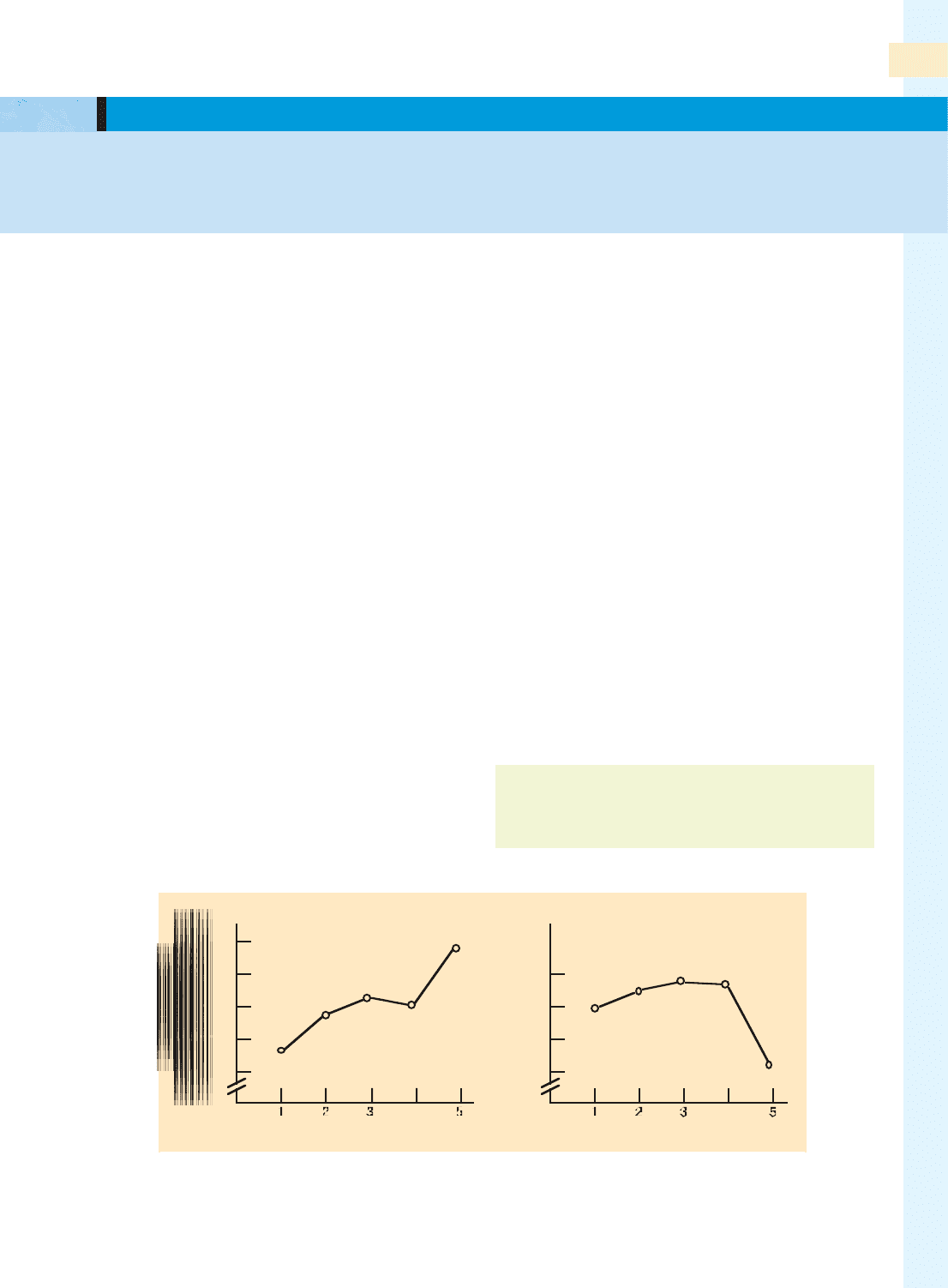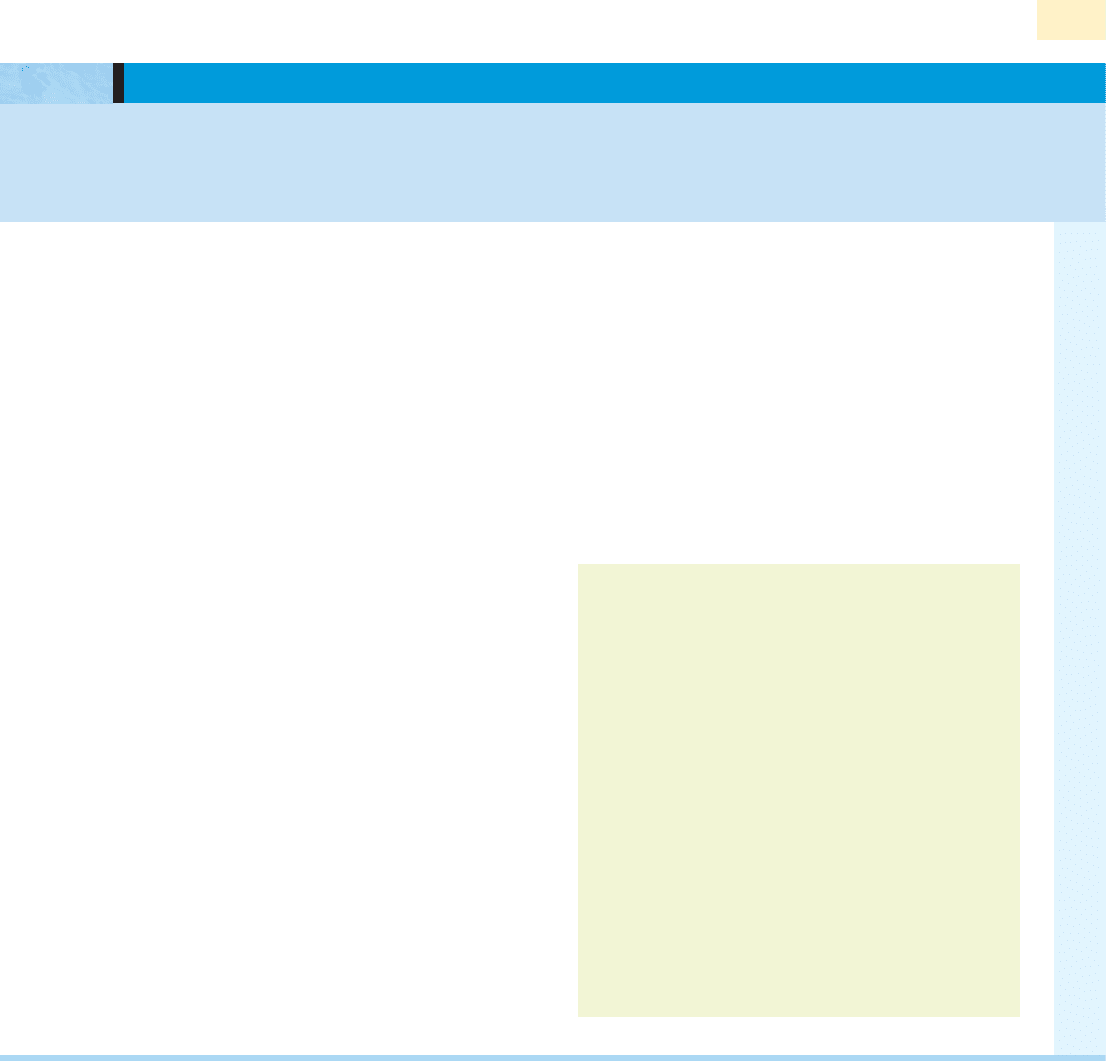Mullins L.J. Management and organisational behaviour, Seventh edition
Подождите немного. Документ загружается.


CHAPTER 18 JOB SATISFACTION AND WORK PERFORMANCE
NATIONWIDE BUILDING SOCIETY
Nationwide Building Society is one of the founder members
of the Employers for Work-Life Balance alliance and has for
some considerable time acknowledged the business benefits
of providing employee choice, to enable employees to bal-
ance home and work lives.
Nationwide has introduced a wide range of policies, prac-
tices and procedures to support this, including a range of
flexible working options (part-time, job share, term-time,
homeworking, annualised hours, compressed working week)
and leave policies that benefit men and women who may
have different responsibilities at different life stages. These
include enhanced maternity leave, parental leave, paternity
leave, employment break, domestic and family leave and an
extended holiday scheme.
Nationwide is fully committed to equal opportunities for
both its customers and employees and lists a number of busi-
ness benefits:
■ Greater access to a wider recruitment pool from which to
recruit the best person for the job.
■ Ability to attract, recruit and retain employees, which has
resulted in reduced tumover, recruitment and training
costs, and has identified that:
–a multi-skilled and diverse workforce that reflects the
customer base has helped the business to understand
customer needs and develop appropriate business
solutions; and
– good work-life practices demonstrate that Nationwide
values the contribution of all its employees, which has
in turn improved ‘commitment, motivation, morale and
productivity’ and ‘reduced stress and absenteeism’.
Satisfied employees = satisfied members
Nationwide’s external statisticians tell them that for every 3%
increase in employee satisfaction, there is a 1% increase in
member satisfaction:
■ Flexible working practices were introduced in 1995.
Since 1996, there has been a 14% increase in employee
satisfaction.
■ In the latest annual employee satisfaction survey, 77% of
Nationwide’s employees agreed with the statement ‘I am
satisfied Nationwide provides me with the opportunities to
balance working arrangements with my personal life’. This
is an increase of 5% on the previous year.
Maternity return rate
■ Nationwide’s current maternity return rate is 91.5% – a
30% increase over the last 10 years, resulting in a saving
of over £3 million.
■ During the last year the company has seen an increase of
nearly 8% of employees returning on a part-time or flex-
ible working arrangement following maternity leave.
Costsofturnover
■ Employee turnover is one of the lowest in the industry at
9.8%, compared with the financial services sector average
of 24%. Nationwide has estimated that to move to the
average, they would need to have recruited an additional
2000 employees last year at a cost of £10 million in
recruitment and training.
Workforce profile
■ Nationwide’s workforce is made up of 76% women and
24% men.
■ Ethnic minority employees make up 6.51% of the total
workforce, in the upper quartile in the Financial Sector.
■ Employees over 50 represent 10% of the workforce and
employees under 25 represent nearly 18% of the total
workforce.
■ Women in senior management account for 17.27% of the
workforce.
BT
British Telecommunications PLC is one of the founder members
of the Employers for Work-Life Balance alliance. It has 118,000
employees in the UK and now offers ‘Lifestyle Working’.
Lifestyle Working started as a one-year pilot in Cardiff and
Swindon Software Engineering centres due to retention
issues among women. This is now also an issue for men as
more men than women in BT have childcare responsibilities.
BT offers a number of benefits and entitlements to meet the
needs of families in order for them to balance their profes-
sional and personal fives.
The successes and benefits of the pilot to all concerned
were so great that the practices have been expanded to other
teams and units within BT; and it is being used as a case
study and model for the entire BT Group:
■ More than 50% of participants and line managers felt
it had improved their perception of BT as employer of
first choice.
■ More than 50% felt more fulfilled at work since commen-
cing ‘Lifestyle Working’.
■ 50% felt they had maintained or improved their individual
efficiency.
Other findings include:
■ Project management skills were enhanced due to the need
to organise work.
MANAGEMENT IN ACTION 18.3
Work-Life Balance case studies
735

736
PART 7 MANAGEMENT OF HUMAN RESOURCES
■ Team members became skilled in covering for the partici-
pant if they were out of the office, leading to a good
transfer of knowledge and better succession planning.
■ Team performance increased due to better succession
planning and cover.
■ Productivity increased, since participants could work in a
quieter office environment out of hours, with fewer inter-
ruptions and improved concentration.
■ The working day could be extended to meet deadlines
without the need for overtime.
■ Great benefits for teams working with customers and col-
leagues across time zones, since people were allowed to
work later or start earlier, providing the team with
increased cover and a saving of the cost of overtime.
■ People who were able to work at home on specific tasks
were more efficient due to reduced levels of interruption.
■ People want to transfer into areas where there is ‘Lifestyle
Working’.
■ Change in working patterns have meant that people are
more focussed, alert and concentrated.
■ Line managers said participants’ performance ‘dramati-
cally improved since being on the trial’.
■ Participants felt ‘loyalty to BT as an employer of choice’ –
one person turned down a better paid job as a result of
the flexibility offered by the trial. Three people returned to
full-time working from part-time because of the increased
flexibility on offer. Lifestyle Working means they don’t have
to attend the office five days a week.
■ Employees ‘are happier and less stressed’.
■ There’s ‘greater personal satisfaction and therefore greater
motivation’.
© Crown Copyright. DTI, Work-Life Balance: The Business Case, September
2001. Reprinted with permission.
Misconceptions exist about flexible working. Most people
would not think of it as the first choice for someone aspiring
to a senior job in the company. People wonder how it is pos-
sible to work part-time and still meet customer needs or
manage a team, let alone keep an eye on career progression.
The 2003 Global Pulse Survey showed that two thirds of
IBMers still believe colleagues would question their commit-
ment to IBM if they were to work flexibly.
Evidence shows that flexible working can benefit all con-
cerned. An external survey* showed that 70% of those who
work flexible hours scored higher than their full-time col-
leagues on resilience, leadership and commitment – and also
produced more work. IBM’s part-time employees include
men and women with roles as senior managers in strategy
and solutions; Client Services Manager; senior consultants;
distinguished engineers; cluster leaders; business develop-
ment and as Partners. At IBM there is no reason why people
in part-time roles should not enjoy fulfilling jobs and strong
career prospects.
‘As part of making IBM the employer of choice and
encouraging the right people to stay in IBM, working flexibly –
which usually means part time – should be available as a pos-
itive option for IBMers’ says Larry Hirst, CGM. ‘I want people
who are 100% commited to IBM, whether full time or part
time – the success of flexible working depends on the atti-
tude of everyone involved.’
Many IBMers are finding that flexible hours work for them
and for their part of the business. lntralink spoke to two of
them (see below). But others still come up against barriers.
That’s why HR will be working with managers to explain ben-
efits of flexible working and have introduced practical
changes to make it easier. And flexible working can also work
to IBM’s advantage. People working non-standard hours can
help us cope with busier and quieter times for our customers.
And as an employer, enabling people to find the work life bal-
ance that suits them is yet another way we are making IBM a
great place to work.
‘It is partly about removing disincentives to managers to
accommodate flexible working – so for example a part-time
employee no longer counts against 70% of headcount,
unless they are actually working a 70% week,’ explains HR
Director, Paul Rodgers. ‘But also it is about changing the cul-
ture. At the moment we see a dropping off in the proportion
of employees who work flexibly as you go up the bands. But
there is no reason at all why people who work outside the
standard Monday-Friday pattern should not aspire to senior
positions in this company.’
So what is flexible working? As well as the more estab-
lished patterns of part-time working (shorter or fewer days in
the week) IBM can offer unusual alternatives, such as working
eight day fortnights, or working full time on a project then
taking a few weeks off when the bid is won or the customer
installation completed. IBM’s strength in mobile working
makes it easier to be truly flexible if an urgent customer need
suddenly comes to light. ‘In this industry none of us can fully
plan our work so that we never work outside our regular
Management in Action 18.3 continued
MANAGEMENT IN ACTION 18.4
Beyond the nine-to-five
Flexible working is becoming an increasingly significant issue. For employees this reflects the growing importance of work-life
balance. For companies it is part of the war for talent, as they look at ways of improving retention, increasing productivity and
becoming the employer of choice.

CHAPTER 18 JOB SATISFACTION AND WORK PERFORMANCE
737
hours’, says Paul. ‘There are very few roles that demand full-
time, conventional working. Part-time team members are just
as skilled as full-timers in juggling their work and outside prior-
ities, from time to time, to take care of the occasional crisis.’
While flexibility is an important element in IBM’s diversity
policies, it is not just a women’s issue. Work life balance is now
the most important issue for UK employees in a range of indus-
tries. At IBM one of our most senior part-time employees in the
UK is the IGS Business Development Director, Tim Shercliff –
and he is enthusiastic about the benefits working part time can
bring to individuals and to the company. Tim experienced
some scepticism from colleagues when he first went part time
two and a half years ago, but now people have seen that the
arrangement can work and are generally supportive.
Focus
‘Working shorter hours has encouraged me to stand back
from the day-to-day issues and think about what is important,
helping the whole IGS organisation remain focused. That’s
what my current job is all about,’ says Tim.
Tim’s career manager, Gary Kyle, is adamant that with the
right management climate part-time IBMers can maintain
their careers. ‘The key is to be flexible, organised and able to
delegate,’ says Gary. ‘Flexible working is an important issue
for IBM. We must become more supportive of people who do
not fit the standard five day week profile, or we will lose tal-
ented individuals.’
Tim has found a growing network of part-time employees
in IBM, who can learn a lot from each other. People have dif-
ferent reasons for wanting to work flexibly. Part-time
managers in IBM include a ballroom dancing instructor (see
opposite) and people running separate businesses, as well as
the larger group – men and women – who choose to keep
some hours of the week to spend with family
Paul’s advice to anyone thinking about working flexibly is
to ask – your manager, or ask HR for advice. ‘The reality is
that for most people in IBM a full time job is the option that
suits them best, and our mobile working technology and
management structures make it easier for people to juggle
full-time work with their home lives. But if you are thinking
about changing the way you work don’t be put off by worries
about your career, IBM wants to keep good people, and we
will help you.’
* Knell, J. and Savage, C. ‘Desperately Seeking Flexibility’, 2001.
IBM UK’S FLEXIBLE WORKING PROGRAMME
(Including changes resulting from UK Family Friendly legisla-
tion effective 6 April 2003)
The right to apply for flexible working is open to parents who
meet the following criteria:
■ He or she is an IBM employee, and:
■ Has a child under the age of six, or under eighteen where
the child is disabled.
■ Has responsibilty for the upbringing of the child and is
making the application to enable them to care for the child.
■ Is the mother, father, adopter, guardian or foster parent of
the child or is married to, or the partner of the child’s
mother, father, adopter, guardian or foster parent.
■ Has worked continually for IBM for 26 weeks.
■ Has not made another application for flexible working
under the right during the last 12 months.
FLEXIBLE WORKING IN ACTION: JOHN FOSKETT
From Monday to Wednesday John Foskett works as a
Consultant IT Architect on the Cable & Wireless account. In
the evenings and on Thursdays and Fridays he teaches
classes and works on accounts and marketing for the
Ballroom and Latin American dancing school established by
his wife in Dorking, Surrey.
Until 1992 when they turned professional John and his
wife Linda were international amateur ballroom dancing com-
petitors and part of the British amateur ballroom dancing
team. Linda set up the dancing school after they turned pro-
fessional, and four years ago gave up outside work to
concentrate on the school and on family commitments.
Demand for the classes grew, and by last summer John was
finding it difficult to fit in five long days at IBM with evenings
and weekends teaching dance classes, and sharing in the
care of the couple’s young son.
‘I discussed the demands on my time with my then man-
ager last summer. We looked at a number of options. There
was a successful precedent for reduced hours working in the
department, and I moved to a 25
1
/
2
hour week in August 2002’,
says John. To date everything has gone smoothly. John’s cus-
tomer and team members know that he works part time. ‘The
one area where I have made changes is in attending meetings,
many of which take place on Thursdays’ explains John. ‘Now I
look at the agenda and input any comments by email or via a
colleague. and catch up on the minutes afterwards’.
John is clear on the benefits of working part time. ‘I have
far more energy, and am more organised about prioritising my
work.’ When asked if he would return to full time working,
John hesitates. ‘That’s a difficult question. I love working for
IBM and want to stay here. The current arrangement works
with my current team and customer, and suits my life outside
work. Whether I stay part time in the future depends on my
role in the company.’
FLEXIBLE WORKING IN ACTION: MARGARET IMMINK
Margaret lmmink works a 60 per cent schedule as a Partner
in Business Consulting Services. She says that flexibility is
the key.
Margaret’s clients are currently based in Europe and in
Asia. ‘As far as possible I try to restrict travelling to the early
part of the week, and have Thursday and Friday to spend
time with my daughter. But if I end up taking calls or spending
extensive time checking email at the end of the week, I can
usually trade an hour with my family on a Monday or Tuesday,
or another time when I’m in the UK.’
The fact that Margaret works part time has not been an
issue for her clients, ‘I am dealing with senior-level people
with busy diaries, we schedule discussions at times that suit
both of us. For the most part my clients do not know that I
work part time, the point for them is that I am around when
they need me and they probably think I am working with other
clients on my time off.’

738
PART 7 MANAGEMENT OF HUMAN RESOURCES
Margaret was in the process of becoming a partner in
PwC in the US when she first suggested that in the future she
would like to move to a part-time schedule. At that time in
1999 the Idea, of operating as a part-time partner, was almost
unknown. After her daughter was born she gained agreement
to trail a 60 per cent schedule, and to meet quarterly with the
Business Unit leader to discuss how this was working. When
she moved to the UK two years ago she remained on a
60 per cent schedule.
Overall the arrangement works well, although Margaret
does need to prioritise her time to concentrate on client
engagements. ‘I am often not around for internal meetings or
activities such as presentations on new offerings, and can
sometimes feel I am missing out’, she admits. ‘But as a
Partner I can control my own time and it is relatively straight-
forward to be flexible when needed. The next big challenge
going forward will be to work with customers to adapt to
dealing with part time consultants and managers, and for IBM
BCS to open up new opportunities for flexible working for the
next generation who are coming through.’
Reproduced with permission from Paul Rodgers, HR Director, Intr@linkUK, IBM,
Spring 2003, pp. 32–3.
Management in Action 18.4 continued
1 What exactly do you understand by job satisfaction? What are the main dimensions of
job satisfaction? Give specific examples of causes of job dissatisfaction that you have
experienced.
2 Debate critically the extent to which you believe that stress is an inevitable feature of
modern work organisations.
3 What factors are likely to influence job design and what factors might affect its potential
success? Contrast different approaches to job design and give examples of situations in
which these approaches might be appropriate, and acceptable, to the staff concerned.
4 Discuss critically the extent to which you believe theories of job enrichment lead to
improved job satisfaction. Where possible, give practical examples in support of your
answer.
5 Outline the core dimensions of a job. Estimate the approximate Motivating Potential Score
(MPS) for any job that you have held and/or attempt to establish the likely MPS for a job
that you hope to have in the future.
6 Why do you think that increasing attention is being given to the work/life debate? As a
manager, detail the main areas in which you could take action in order to improve the qual-
ity of working life of staff.
7 Debate the potential benefits and limitations of employee involvement and empowerment.
Where possible, support your answer with practical examples.
8 Explain fully the essential features of (i) self-managed work groups (ii) teleworking; and (iii)
a quality circle group.
9 Evaluate critically the relationship between job satisfaction and effective work perform-
ance. Give reasons in support of your views.
REVIEW AND DISCUSSION QUESTIONS

CHAPTER 18 JOB SATISFACTION AND WORK PERFORMANCE
The following is a question, reproduced with permission, from the Institute of Chartered
Secretaries and Administrators Examination paper.
‘Downsizing’ of personnel numbers often leads to job enlargement and job rotation so
should create job enrichment and motivation. Discuss this proposition.
Working in small self-selecting groups, set out your response as fully as possible and give
practical examples in support of your answer. How much agreement is there among members
of your group?
a Undertake a detailed review of the extent to which flexible working arrangements have
been introduced in a range of different organisations (for example by questioning your col-
leagues about their work experiences, and those of their families and friends).
b Detail critically the apparent effectiveness of these arrangements and their influence on job
satisfaction and perceived work performance.
c As part of your investigation explain why, despite the many apparent potential advantages,
working from home has not been adopted by organisations or staff to the extent that might
be expected.
ASSIGNMENT 1
ASSIGNMENT 2
739

740
PART 7 MANAGEMENT OF HUMAN RESOURCES
OBJECTIVES
Completing this exercise should help you to enhance the following skills:
Identify the scale to which different things cause you stress.
Examine relationships between causes of stress and motivation at work.
Recognise that topics studied in organisational behaviour are not freestanding.
EXERCISE
You are required to:
1 Write down in 10 minutes as many things as you can that cause you stress:
2 Put your list in order by writing 1, 2 and 3 against the top stressors.
3 Choose a partner, according to the tutor’s guidelines.
4 Exchange your Motivation scores (from the Exercise in Chapter 12) with your partner, but
not your list of stressors. Keep this to yourself for now.
5 Look at your partner’s Motivation scores and note what you think would be their top three
causes of stress. They will do the same for you.
6 Discuss your findings with each other. How close did you get?
DISCUSSION
■ How would you explain to a sceptical listener the interrelationships between stress and
motivation?
■ In addition to motivation what other topic(s) studied in organisational behaviour do you
think has a significant relationship with stress at work?
Visit our website www.booksites.net/mullins for further questions, annotated weblinks,
case material and Internet research material.
PERSONAL AWARENESS AND SKILLS EXERCISE

CHAPTER 18 JOB SATISFACTION AND WORK PERFORMANCE
RIO COSMETICS LTD
Rio Cosmetics has chosen to concentrate its effort
on what it regards as the most lucrative section of
the market. As its marketing manager says, ‘We’ve
gone for short-term profit maximisation – rather
than for diversification.’ Its production is therefore
concentrated on a single tube of deodorant mar-
keted under the brand name ‘Freche’. The product is
heavily advertised on TV and Rio has made consid-
erable profits over the past 5 years. However, a
substantial competitor has now entered the market,
and Rio’s share of the market has dropped to 18 per
cent, its lowest level in three years.
The board is now looking for explanations. They
have asked for reports from the Sales and
Production Departments. They have also asked the
Personnel Department to report on some disturbing
statistics regarding the workforce. In particular:
1 There has been a dramatic increase in absen-
teeism over the last year.
2 Although the number of line workers has
remained fairly stable (at around 2115 during the
last four or five years), weekly average output has
fallen from 312 000 to 287 000 units.
3 During the last year 21 per cent of the line work-
ers have been late at least once a week, in spite of
the fact that they lose a quarter of an hour’s pay
when this happens. (Before this year the figure
was fairly constant at around 10 per cent.)
In addition, within the past four months, the number
of consumers complaining direct to the company has
doubled according to the information supplied by the
Quality Control Department, who keep a record of
the number of letters received each week. They advise
that the majority of these complaints have been
traced back to what they describe as ‘human errors’
on the production line. Furthermore, three serious
cases of pilfering have been notified by the Security
Section within the past week.
Other information available
The rate of pay is approximately 10 per cent higher
than could be obtained by the line workers elsewhere.
Older workers are not discouraged, but the average
age of the workforce is only 19 years. It is increasingly
difficult to find acceptable line supervisors.
Production starts at 8 am and finishes at 5 pm –
5 days a week – with an hour lunch break and two
20-minute tea breaks.
The graphs shown have been prepared covering
labour turnover and absenteeism over the past
five years.
YOUR TASK
What explanations and recommendations would you
offer the Board of Directors?
CASE STUDY 18.1
The wide open spaces: linking job satisfaction and work
performance
741

742
PART 7 MANAGEMENT OF HUMAN RESOURCES
The changing role of supervisors: demonstrating the effect of
communication and training on morale
You are a management consultant called in to advise
an organisation which has undergone significant
change, involving both voluntary and compulsory
redundancies, in the last two years. Employee mem-
bers have reduced by 60 per cent while the workload
has remained unchanged for the organisation as a
whole. Employees, including managers and supervi-
sors, now work under significantly increased work
pressure. Senior management are concerned about
the low morale and commitment to the organisa-
tion which they now perceive among the remaining
workforce. Six months ago the senior management
team decided to introduce a major exercise to
improve communication within the organisation.
They wanted employees at all levels to understand
better the problems of the organisation, the man-
agement strategy adopted to deal with these
problems, and the senior management team’s grow-
ing confidence that the situation was now
improving significantly. Productivity and cost effec-
tiveness had improved substantially. Moreover,
major programmes of technical improvement and
investment were now under way.
One important element of this programme was a
training course in interactive skills for first-line
supervisors. The personnel manager has told you
that this programme has failed.
Personnel Manager: ‘We wanted to build up the
supervisors’ role with their own people. Therefore
we wanted the supervisors to talk with their people
about our plans and to get their ideas and views. We
put them through a one-week course in interactive
skills and human relations skills. But it failed. They
enjoyed the course. They all said they gained a lot
from it. But when we asked them to communicate
to their people about plans for this year, they said
they did not feel confident enough.’
Consultant: ‘Do they understand the plans? Do you
feel that the plans have been presented to them in a
clear enough way? Are their own managers commu-
nicating effectively with the supervisors? Do their
managers provide support and encouragement to
the supervisors?’
Personnel Manager: ‘I’m not sure, possibly not. We
give them copies of our detailed plans. They see
everything. In any case I think they are afraid of
being criticised by their staff. They don’t want argu-
ments with them and they don’t feel sure enough
about the plans. They wonder about job losses in
the future.’
The role of first-line supervisors had been changed
with the introduction of a professional Personnel
Function. Supervisors no longer fully understood
the terms and conditions of employment, bonus
schemes, job evaluation systems and employment
legislation relevant to the organisation. Moreover
the staffing reductions had meant that supervisors
were increasingly taking on tasks once carried out
by their subordinates. Thus the role of the super-
visor had come to be solely a technical, and no
longer a managerial role.
CASE STUDY 18.2
YOUR TASKS
(a) Assess the effectiveness of the training pro-
gramme, identifying the problems experienced.
(b) Identify the main issues you feel will need atten-
tion if communications within this organisation are
to be improved.
(c) State what advice you will offer to the organisation
about how to proceed from the current situation.

CHAPTER 18 JOB SATISFACTION AND WORK PERFORMANCE
743
The Falcon Car Company, based in Sweden, was for
many years experiencing labour dissatisfaction with
its traditional moving assembly lines of production.
This was reflected in high levels of absenteeism and
personnel turnover, as well as recruiting difficulties
at its plants.
To make the jobs more interesting, the plants
were designed so that the workers could operate in
teams. Instead of repeating a single short task, each
operator was trained to do all the jobs in their
team’s area. Each team has its own entrance, chang-
ing room, coffee room and sauna. The factory has
been built as six distinct product workshops, each
fully equipped to build a whole car, rather than
mere sub-assembly. Falcon allows its workers time
off for further education and lengthy paternity or
maternity leave. Wages are comparatively good at
Falcon and are supplemented by bonuses for high
quality work. Production workers have the opportu-
nity to be promoted from the shop floor to more
senior positions. Mr Karlberg, the Production
Manager, was once himself a production line worker
at Falcon cars.
Cars are rigorously checked throughout the
assembly process. Each team tests its own work
before the car passes to the next team. If faults are
identified, they are traced to the operator respons-
ible and noted on a board in their area. If faufts are
frequent or serious, their supervisor will take the
operator to see the car and point out the problems.
‘We let people know their mistakes in a positive
manner. We don’t go round with a whip,’ says Mr
Karlberg. The human lessons that Falcon has
learned have eased the difficulties the company ini-
tially experienced with high absenteeism, high
turnover of staff and recruitment.
‘The factory is the closest car assembly has come to
building on the spot, with operators standing still
and components coming to them. People are getting
more and more educated, so industry has to become
more and more interesting,’ says Mr Karlberg.
The consequences of the changes implemented
by Falcon Cars are that morale and motivation have
visibly increased. The evidence that staff turnover
and absenteeism levels have significantly dropped
confirm this.
YOUR TASKS
In the role of Mr Karlberg, the Production Manager of
Falcon cars, write a report for the attention of the
Managing Director of Falcon Cars, that answers the
following questions.
(a) Suggest reasons why Falcon Cars was experien-
cing high staff turnover, high absenteeism and
general dissatisfaction with its traditional moving
assembly line.
(b) Why has the Falcon Car Company provided the
teams of workers with their own entrance, chang-
ing room, coffee room and sauna?
(c) By applying appropriate theory, explain why the
workers’ motivation has improved.
(d) Using Falcon Cars as an example, what factors
need to be addressed and means used in order to
change a company’s culture?
Flying like the wind: motivation, job design and culture at
Falcon Car Company
CASE STUDY 18.3

744
PART 7 MANAGEMENT OF HUMAN RESOURCES
1. Herzberg. F. ‘One More Time: How do you Motivate
Employees?’, Harvard Business Review, vol. 46, 1968,
pp. 53–62.
2. Luthans, F. Organizational Behaviour, Seventh edition,
McGraw-Hill (1995), p. 129.
3. Bassett, G. ‘The Case Against Job Satisfaction’, Business
Horizons, vol. 37, no. 3, May–June 1994, pp. 61–8.
4. Reeves, R. ‘Reality Bites’, Management Today, May
2003, p. 37.
5. Grunberg, M. M. Understanding Job Satisfaction,
Macmillan (1979).
6. Cane, S. Kaizen Strategies for Winning Through People,
Pitman Publishing (1996), p. 114.
7. See, for example: Torrington, D., Hall, L. and Taylor, S.
Human Resource Management, Fifth edition, Financial
Times Prentice Hall (2002).
8. Handy, C. ‘Boring Workplace, Boring Worker’,
Management Today, November 1997, p. 29.
9. ‘The Workplace Survey’, Chartered Management
Institute, March 2003.
10. Myerson, J. ‘Workspace Heaven?’, Management Today,
June 2003, pp. 53–61.
11. Simons, T. and Enz, C. A. ‘Motivating Hotel Employ-
ees: Beyond the Carrot and the Stick’, Cornell HRA
Quarterly, February 1995, pp. 20–7.
12. Mumford, E. ‘Job Satisfaction: A Method of Analysis’,
Personal Review, vol. 20, no. 3, 1991, pp. 11–19.
13. Marx, K. ‘The Notion of Alienation’, in Coser, L. A.
and Rosenburg, B. Sociological Theory, Collier
Macmillan (1969), pp. 505–10.
14. Blauner, R. Alienation and Freedom, University of
Chicago Press (1964).
15. See, for example: Huczynski, A. and Buchanan, D.
Organisational Behaviour: An Introductory Text, Fourth
edition, Financial Times Prentice Hall (2000).
16. Daily Mail, Friday, 23 June 2000
17. Lucas, E. ‘Keep It Formal for Maximum Flexibility’,
Professional Manager, March 2000, p. 10.
18. Thomas, R. ‘The World Is Your Office’, Management
Today, July 1999, pp. 78–84.
19. Law, S. ‘Future Networking’, Professional Manager,
March 2003, p. 21.
20. Reeves, R. ‘Reality Bites’, Management Today, December
2002, p. 35.
21. Financial Times, 8 May 2000.
22. For a fuller discussion see, for example: Arnold, J.
Cooper, C. L. and Robertson, I. T. Work Psychology:
Understanding Human Behaviour in the Workplace, Third
edition, Financial Times Pitman Publishing (1998).
23. McKenna, E. Business Psychology and Organisational
Behavior, Lawrence Erlbaum (1994), p. 585.
24. Lucas, E. ‘Work and Sickness’, Professional Manager,
vol. 12, no. 4, July 2003, pp. 32–3.
25. ‘Business’, The Herald, 17 October, 2002, p. C7.
26. Broad, M. ‘Rising Stress at Work Costs £4bn a Year’,
The Sunday Times, 1 September 2002.
27. York, P. ‘Getting a Grip on Stress’, Management Today,
October 2001, p. 105.
28. Orpen, C. ‘Want The Best? Get Stressed!’ Chartered
Secretary, August 1996, pp. 18–20.
29. Gwyther, M. ‘Stressed for Success’, Management Today,
January 1999, pp. 22–6.
30. ‘Managing Stress at Work’, Engineering Employers’
Federation, 2001.
31. Armson, S. ‘Putting Stress on the Bottom Line’,
Management Today, September 1997, p. 5.
32. Hall, K. and Savery, L. K. ‘Stress Management’,
Management Decision, vol. 25, no. 6, 1987, pp. 29–35.
33. Are Managers Under Stress?: A Survey of Management
Morale, The Institute of Management, September 1996.
34. See, for example: Ridd, J. ‘Hidden Costs of Work Stress’,
The British Journal of Administrative Management,
October/November 1994, pp. 14–15.
35. Jamison, C. ‘Top 10 Myths of Customer Service’, The
British Journal of Administrative Management, July/August
1999, pp. 19–21.
36. Handy, C. B. Understanding Organizations, Fourth edi-
tion, Penguin (1993).
37. Taylor, M. ‘Tell Me Why I Don’t Like Mondays’,
Working Paper of the Institute for Social and
Economic Research, October 2002.
38. Randall, J. ‘Home Truths’, Management Today, June
2001, p. 31.
39. ‘Work-related stress: A short guide’, Health and Safety
Executive, November 2001. See also: ‘Organisational
Interventions for Work Stress: A risk management
approach’, Health and Safety Executive, 2000.
40. Black, O. ‘Making Stress Work for You’, Management
Today, December 2001, p. 19.
41. ‘Managing Stress at Work’, Engineering Employers’
Federation, 2001.
42. Reeves, R. ‘Reality Bites’, Management Today, March
2003, p. 35.
43. Vine, P. and Williamson, J. ‘Run Down, Stressed Out’,
The British Journal of Administrative Management,
January/February 1998, pp. 14–17.
44.
Van ZylKobus Lazenby, E. ‘The relation between ethical
behaviour and workstress amongst a group of managers
working in affirmative action positions’, Journal of
Business Ethics, vol. 40, no. 2, October 2002, pp. 111–19.
45. Hayes, D. and Hudson, A. Attitudes to Work, Education
and Work Research Group (2000), reprinted with
permission.
46. Burns, B. Managing Change: A Strategic Approach to
Organisational Dynamics, Third edition, Financial
Times Prentice Hall (2000), p. 69.
47. Hackman, J. R. and Oldham, G. R. Work Redesign,
Addison-Wesley (1980).
48.
Lee-Ross, D. ‘The Reliability and Rationale of Hackman
and Oldham’s Job Diagnostic Survey and Job
Characteristics Model among Seasonal Hotel Workers’,
International Journal of Hospitality Management, 17, 1998,
pp. 391–406.
49. Roe, R. A., Zinovieva, I. L., Dienes, E. and Ten Horn, L.
A., ‘A Comparison of Work Motivation in Bulgaria,
Hungary and the Netherlands: Test of a model’,
Applied Psychology: An International Review, vol. 49,
2000, pp. 658–87.
50. Wilson, N. A. B. On the Quality of Working Life: report
prepared for the Department of Employment,
Manpower Paper no. 7, HMSO (1973).
NOTES AND REFERENCES
